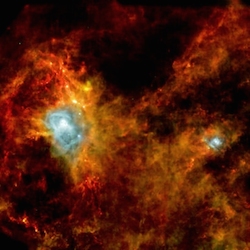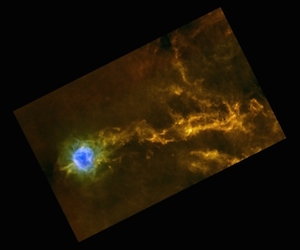Herschel's hunt for filaments in the Milky Way
28 May 2015
Observations with ESA's Herschel space observatory have revealed that our Galaxy is threaded with filamentary structures on every length scale. From nearby clouds hosting tangles of filaments a few light-years long to gigantic structures stretching hundreds of light-years across the Milky Way's spiral arms, they appear to be truly ubiquitous. The Herschel data have rekindled the interest of astronomers in studying filaments, emphasising the crucial role of these structures in the process of star formation.
Stars are born in the densest pockets of the interstellar medium, a diffuse mixture of gas and dust that pervades galaxies, including our Milky Way. One of the most intriguing questions in astrophysics concerns understanding how this material, which is typically characterised by very low density, can come together, creating denser concentrations that later evolve into compact cores and, finally, give birth to stars.
In the search for answers, astronomers observe giant molecular clouds, the cosmic incubators where gas and dust are transformed into stars. While these studies are performed using a variety of techniques, one crucial approach is the observation of infrared light, since the interstellar material shines brightly at these long wavelengths.
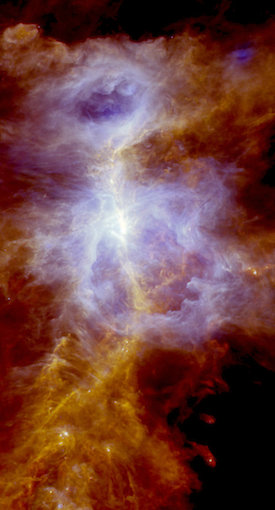 |
| The Orion A Molecular Cloud. Credit: ESA/Herschel/Ph. André, D. Polychroni, A. Roy, V. Könyves, N. Schneider for the Gould Belt survey Key Programme |
In this context, ESA's Herschel space observatory has been a true game changer. Probing the portion of the electromagnetic spectrum that ranges from the far-infrared to sub-millimetre wavelengths, it has collected unprecedented data during its three and a half years of observing. One of the key aspects that emerged from these observations is the presence of a filamentary network nearly everywhere in our Galaxy's interstellar medium. The picture that is emerging is that these structures are closely linked to the formation of stars.
Prior to Herschel, astronomers had already identified several filaments in interstellar clouds and recognised their potential importance for star formation. However, only with the increased sensitivity and spatial resolution granted by this observatory, combined with its large-scale surveys, could they reveal the full extent of filamentary patterns in the Milky Way.
One of the surveys performed with Herschel – the Gould Belt Survey – focussed on a giant ring of star-forming regions, all located no more than 1500 light-years away from the Sun. The vicinity of these clouds allowed astronomers to obtain exceptionally detailed images using Herschel, unearthing intricate webs of filaments in each region that they examined.
“The greatest surprise was the ubiquity of filaments in these nearby clouds and their intimate connection with star formation,” explains Philippe André from CEA/IRFU, France, Principal Investigator for the Herschel Gould Belt Survey.
“But there is more: these observations revealed that filaments, which may extend to several light-years in length, appear to have a universal width of about one third of a light year. This suggests that something fundamental is lurking underneath.”
The astronomers are still trying to understand the details of the star formation processes taking place in these clouds, aided by the abundance and variety of data collected with Herschel.
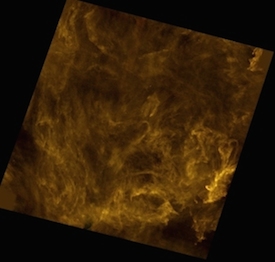 |
| The Polaris Flare. Credit: ESA/Herschel/SPIRE/Ph. André for the "Gould Belt survey" Key Programme Consortium and A. Abergel for the "Evolution of Interstellar Dust" Key Programme Consortium |
While most filaments are dotted with compact cores, suggesting that stars are readily taking shape in these dense 'fibres' of the interstellar medium, there are also regions that exhibit complex tangles of filaments but no signs of on-going star formation. A study of the most spectacular example of this phenomenon, the Polaris Flare, indicates that filaments must somehow precede the onset of star formation.
The scenario that has emerged from the new Herschel data suggests that star formation proceeds in two steps: first, turbulent motions of the interstellar gas and dust create an intricate web of filamentary structures; then, gravity takes over, causing only the densest filaments to contract and fragment, eventually leading to the formation of stars.
Indeed, the universal width of filaments seems to correspond, at least in the nearby clouds of the Gould Belt Survey, to the scale at which interstellar material undergoes the transition from supersonic to subsonic state.
In addition, the material along filaments is not at all static: astronomers have detected what appear to be accretion flows, with the most prominent filaments drawing matter from their surroundings through a network of smaller filaments. A striking example of such processes is seen in the Taurus Molecular Cloud, where the B211/B213 filament exhibits a series of so-called 'striations' perpendicular to the main filament.
This pattern is very similar to that predicted from numerical simulations that model the process of star formation in molecular clouds. According to these simulations, interstellar material flows towards dense filaments along routes that are parallel to the direction of the local magnetic field, as was observed, so the new data indicate the importance of interstellar magnetic fields in shaping these structures.
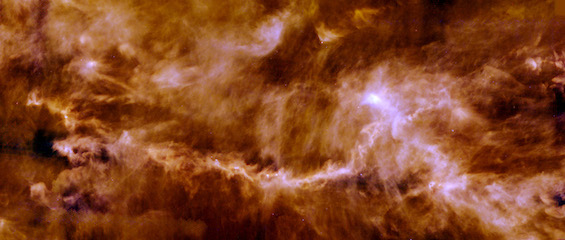 |
| The B211/B213 filament in the Taurus Molecular Cloud. Credit: ESA/Herschel/PACS, SPIRE/Gould Belt survey Key Programme/Palmeirim et al. 2013 |
However, star formation does not appear to take place only in filaments. While these structures seem to be the preferred sites for stellar birth, the extraordinary data from Herschel confirmed that a small fraction of stars may also form far away from dense filaments.
In particular, a detailed study of the L1641 molecular clouds in the Orion A complex suggests that star formation along filaments is the preferential channel to produce typical solar-type stars, while stars that are born away from these dense, elongated structures tend to have lower masses. This dichotomy could be a result of the greater availability of raw material to protostars that are forming on a filament compared to those that take shape in less dense environments.
Another of Herschel's key findings is that the presence and abundance of filaments are not limited to our immediate neighbourhood. In fact, these structures appear everywhere also in the Herschel infrared Galactic Plane Survey (Hi-GAL), which scanned the distribution of the interstellar medium in the huge disc – about 100 000 light-years across – where most of the Milky Way's stars form and reside.
 |
| The filamentary structure of the Galactic Plane. Credit: ESA/PACS & SPIRE Consortium, S. Molinari, Hi-GAL Project |
“We detected a wealth of huge filaments, with lengths ranging from a few to a hundred light-years, revealing what seems to be the 'skeleton' of our Galaxy,” explains Sergio Molinari from IAPS/INAF, Italy, Principal Investigator for the Hi-GAL Project.
“While it is possible that these structures arose from different physical processes than those giving rise to the small-scale filaments observed in the Sun's vicinity, the omnipresent aspect of filamentary structures in the Milky Way is beyond doubt.”
In the post-Herschel era, one thing is certain: filaments play a leading role in the build-up of galactic material, creating favourable hubs for the formation of stars. This is likely a hierarchical process, starting on very large scales and propagating onwards, to smaller and smaller scales, funnelling interstellar gas and dust into increasingly denser concentrations and thus fostering stellar birth across the Galaxy.
 |
| Filaments in outer regions of the Galactic Plane. Credit: ESA/Herschel/PACS, SPIRE/Hi-GAL Project/Schisano et al. 2014 |
Large-scale filaments fragmenting into compact cores that later evolve into stars have been detected all across the Galactic Plane, even in its outermost, peripheral regions. As filaments grow more massive, the material within them contracts and forms smaller structures, preserving the filamentary pattern on all length scales.
Further investigation of the Hi-GAL survey has revealed new and even more prominent filaments, extending over hundreds of light-years and weaving their way through the spiral arms of the Milky Way. The study revealed nine filaments in some very dense, inner regions of the Galactic Plane, detecting these for the first time through the direct emission of dust within them, allowing an accurate determination of their mass, size and physical characteristics. Astronomers believe that almost a hundred similar, gigantic structures are still hiding in the data.
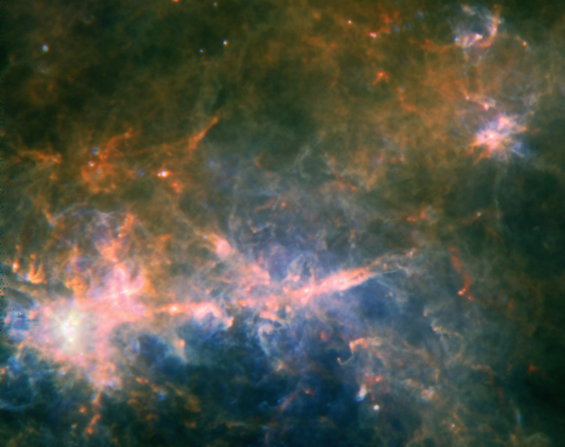 |
|
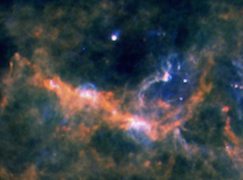 |
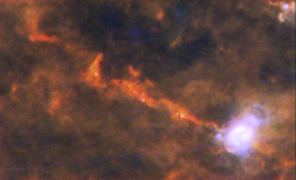 |
| Some of the most prominent filaments detected in the Milky Way: G49 (top), G47 (bottom left) and G64 (bottom right). Credit: ESA/Herschel/PACS/SPIRE/Ke Wang et al. 2015 | |
“The intricate distribution of filaments in the interstellar medium revealed by Herschel has definitely revolutionised our view of how stars form in the Milky Way and, presumably, also in other similar galaxies,” comments Göran Pilbratt, ESA Herschel Project Scientist.
“An increasingly coherent picture is now emerging from combining the analysis of these data with predictions from theory and numerical simulations, as astronomers continue to study the physical processes underlying the fascinating origin of stars and planets.”
More information
Herschel is an ESA space observatory with science instruments provided by European-led Principal Investigator consortia and with important participation from NASA.
Herschel was launched on 14 May 2009 and completed science observations on 29 April 2013.
Contacts
Philippe André
CEA/DSM/IRFU Service d'Astrophysique
Centre d'Etudes de Saclay
Gif-sur-Yvette Cedex, France
E-mail: pandre![]() cea.fr
cea.fr
Phone: +33-1-6908-9265
Sergio Molinari
IAPS/INAF
Roma, Italy
Email: Sergio.molinari![]() iaps.inaf.it
iaps.inaf.it
Phone: +39-06-4993-4396
Göran Pilbratt
Herschel Project Scientist
Scientific Support Office
Science and Robotic Exploration Directorate
ESA, The Netherlands
Email: gpilbratt![]() cosmos.esa.int
cosmos.esa.int
Phone: +31-71-565-3621

